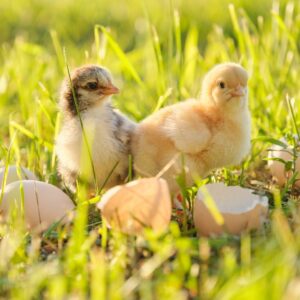 Everything you Need to Know about Raising Baby Chicks: Bringing home your baby chicks is an exciting milestone in raising backyard chickens. The three key essentials for raising baby chicks: Warmth, water and feed. Start chicks strong by providing a complete chick starter feed from day 1 through week 18.raising baby chicks
Everything you Need to Know about Raising Baby Chicks: Bringing home your baby chicks is an exciting milestone in raising backyard chickens. The three key essentials for raising baby chicks: Warmth, water and feed. Start chicks strong by providing a complete chick starter feed from day 1 through week 18.raising baby chicks
For those of us welcoming new chicks how can we give them a solid start?
To best transition chicks into a flock, provide comfort, care and complete nutrition from day one. A chick never gets over a bad start. The actions we take before chicks arrive and the care we provide in the first few days can help set-up our chicks to be happy and healthy long-term.
First things first, visit us for all your Chicken Supplies!!
Before baby chicks arrive: Set up the brooder
Set up your brooder about 48 hours before your chicks arrive. This allows time for bedding and equipment to dry and the temperature to set.
Equipment for day one includes:
Brooder: The brooder is the first home of new chicks. Be sure it is comfortable, warm and draft-free with at least 3 to 4 square feet per chick. The area should be circular and expandable.
Heat lamp: Assemble a heat lamp in the center of the brooder for bird warmth. Hang the heat lamp about 20 inches above the litter, with 2.5 to 3 feet between the lamp and the guard walls. The temperature under the heat lamp, or comfort zone, should be 95 degrees Fahrenheit and adequate room in the brooder should be available for the chicks to get out from under the heater if they get too hot. After week one, gradually reduce heat by 5 degrees Fahrenheit each week until reaching a minimum of 55 degrees.
Bedding: Add an absorbant wood shavings bedding to the floor of the brooder. Place bedding 3 to 4 inches deep to keep the area dry and odor free. Remove wet bedding daily, especially around waterers. Do not use cedar shavings or other types of shavings that have a strong odor because the odor could affect the long term health of the bird.
Lights: Provide 18 – 22 hours of light for the first week. Then reduce light to 16 hours through the growing period or to the amount of light they will receive when they are 20 weeks of age. The amount of light intensity required would be provided by a 40 watt bulb for each 100 square feet (10’ x 10’) of floor space.
Feeders: Offer 4 linear inches of feeder space for each bird. Clean egg cartons filled with feed make excellent and easily accessible feeders for young chicks. Provide low-lying feeders, or trough feeders, for after the transition.
Waterers: For every 25 chicks, fill two 1-quart waterers with room temperature water and place them in the brooder. To help water stay at room temperature, place the waterers in the brooder, outside the comfort zone (do not position underneath the heat lamp), 24 hours prior to the chicks’ arrival.
Introduce baby chicks to water
Once chicks arrive, introduce them to the brooding area. Water, at room temperature, should be available, but wait a couple hours to introduce feed.
This gives chicks a couple hours to drink and rehydrate before they start eating, fresh, quality water is essential for healthy chicks. Dip the beaks of several chicks into the water to help them locate it. These chicks will then teach the rest of the group to drink. Monitor the group to ensure all chicks are drinking within the first couple hours.
Teach baby chicks to eat:
After chicks have had a chance to rehydrate, provide the nutrients they need through a complete chick starter feed. Provide a chick starter feed with at least 18 percent protein to help support the extra energy needed for early growth. The feed should also include amino acids for chick development; prebiotics, probiotics and yeast for immune health; and vitamins and minerals to support bone health.
First, teach the chicks to eat by placing feed on clean egg flats, shallow pans or simple squares of paper. On day 2, add proper feeders to the pens. Once chicks have learned to eat from the feeders, remove the papers, pans or egg flats.
Adjust feed as baby chicks develop:
To keep feed fresh: Empty, clean and refill waterers and feeders daily. Also, raise the height of feeders and waterers so they are level with the birds’ backs as chicks grow. As chicks mature, their nutritional needs change. At age 18 weeks, adjust the feed provided to meet the birds’ evolving nutrition needs.
Transition layer chicks onto a higher-calcium complete feed, like Purina Layena Crumbles or Pellets, when they begin laying eggs at age 18 to 20 weeks. For meat birds and mixed flocks, choose a complete feed with 20 percent protein, like Purina Flock Raiser Crumbles and feed this diet from day one through adulthood.
This post on raising baby chicks has been adapted from purinamills.com.




